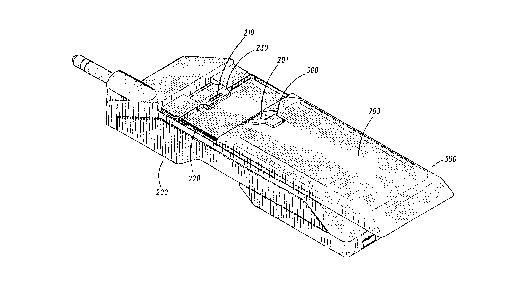Some of the information on this Web page has been provided by external sources. The Government of Canada is not responsible for the accuracy, reliability or currency of the information supplied by external sources. Users wishing to rely upon this information should consult directly with the source of the information. Content provided by external sources is not subject to official languages, privacy and accessibility requirements.
Any discrepancies in the text and image of the Claims and Abstract are due to differing posting times. Text of the Claims and Abstract are posted:
| (12) Patent: | (11) CA 2142722 |
|---|---|
| (54) English Title: | A LATCHING SYSTEM |
| (54) French Title: | SYSTEME DE VERROUILLAGE |
| Status: | Expired and beyond the Period of Reversal |
| (51) International Patent Classification (IPC): |
|
|---|---|
| (72) Inventors : |
|
| (73) Owners : |
|
| (71) Applicants : | |
| (74) Agent: | GOWLING WLG (CANADA) LLP |
| (74) Associate agent: | |
| (45) Issued: | 1999-09-07 |
| (86) PCT Filing Date: | 1994-06-20 |
| (87) Open to Public Inspection: | 1995-02-02 |
| Examination requested: | 1995-02-16 |
| Availability of licence: | N/A |
| Dedicated to the Public: | N/A |
| (25) Language of filing: | English |
| Patent Cooperation Treaty (PCT): | Yes |
|---|---|
| (86) PCT Filing Number: | PCT/US1994/006926 |
| (87) International Publication Number: | WO 1995003642 |
| (85) National Entry: | 1995-02-16 |
| (30) Application Priority Data: | ||||||
|---|---|---|---|---|---|---|
|
The latching system of the present invention uses a ribbed (301, 302) latch
(300) molded into the battery housing, a depression latch
(504) molded into the radiotelephone housing, and rail connectors (220) 320)
molded into the radiotelephone housing to connect a battery
(350) to a radiotelephone (200). The battery housing slides along the rail
connectors until the battery housing latch (300) engages into the
radiotelephone latch (210). The battery housing (350) is removed from the
radiotelephone housing (200) by depressing the upper portion
(300) of the battery housing latch, than rotating it out of the depression
latch (200) and allowing the battery housing to be slid off the
radiotelephone housing (200).
Le système de verrouillage de la présente invention utilise un verrouillage (300) à nervures (301, 302) moulé sur le logement de la batterie, un verrouillage à dépression (504) moulé dans le logement du radiotéléphone et des connecteurs à rails (220, 320) moulés dans le logement du radiotéléphone pour relier une batterie (350) à un radiotéléphone (200). Le logement de la batterie glisse le long des connecteurs à rails jusqu'à ce que le verrouillage dulogement de la batterie (300) s'engage dans le verrouillage du radiotéléphone (210). Le logement de la batterie (350) est enlevé du logement du radiotéléphone (200) en pressant sur la portion supérieure (300) du verrouillage du logement de la batterie et en la faisant tourner ainsi hors du verrouillage à dépression (200) et en permettant au logement de la batterie de se dégager en glissant du logement du radiotéléphone (200).
Note: Claims are shown in the official language in which they were submitted.
Note: Descriptions are shown in the official language in which they were submitted.

2024-08-01:As part of the Next Generation Patents (NGP) transition, the Canadian Patents Database (CPD) now contains a more detailed Event History, which replicates the Event Log of our new back-office solution.
Please note that "Inactive:" events refers to events no longer in use in our new back-office solution.
For a clearer understanding of the status of the application/patent presented on this page, the site Disclaimer , as well as the definitions for Patent , Event History , Maintenance Fee and Payment History should be consulted.
| Description | Date |
|---|---|
| Inactive: IPC expired | 2015-01-01 |
| Inactive: IPC from MCD | 2006-03-11 |
| Inactive: IPC from MCD | 2006-03-11 |
| Time Limit for Reversal Expired | 2002-06-20 |
| Letter Sent | 2001-06-20 |
| Grant by Issuance | 1999-09-07 |
| Inactive: Cover page published | 1999-09-06 |
| Inactive: Final fee received | 1999-06-02 |
| Pre-grant | 1999-06-02 |
| Notice of Allowance is Issued | 1999-03-30 |
| Letter Sent | 1999-03-30 |
| Notice of Allowance is Issued | 1999-03-30 |
| Inactive: Status info is complete as of Log entry date | 1999-03-23 |
| Inactive: Application prosecuted on TS as of Log entry date | 1999-03-23 |
| Inactive: Approved for allowance (AFA) | 1999-03-04 |
| All Requirements for Examination Determined Compliant | 1995-02-16 |
| Request for Examination Requirements Determined Compliant | 1995-02-16 |
| Application Published (Open to Public Inspection) | 1995-02-02 |
There is no abandonment history.
The last payment was received on
Note : If the full payment has not been received on or before the date indicated, a further fee may be required which may be one of the following
Please refer to the CIPO Patent Fees web page to see all current fee amounts.
| Fee Type | Anniversary Year | Due Date | Paid Date |
|---|---|---|---|
| MF (application, 4th anniv.) - standard | 04 | 1998-06-22 | 1998-05-01 |
| MF (application, 5th anniv.) - standard | 05 | 1999-06-21 | 1999-03-19 |
| Final fee - standard | 1999-06-02 | ||
| MF (patent, 6th anniv.) - standard | 2000-06-20 | 2000-05-03 | |
| MF (application, 2nd anniv.) - standard | 02 | 1996-06-20 |
Note: Records showing the ownership history in alphabetical order.
| Current Owners on Record |
|---|
| MOTOROLA, INC. |
| Past Owners on Record |
|---|
| BRIAN J. HASSEMER |
| KENNETH J. ROBACK |
| SCOTT D. BEUTLER |